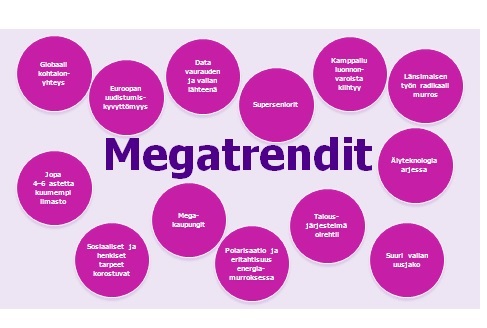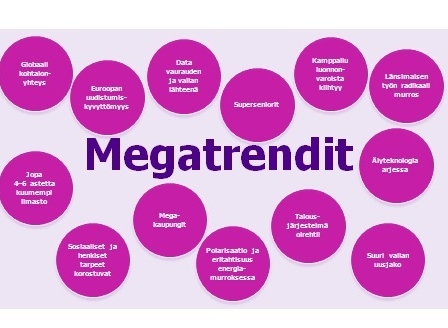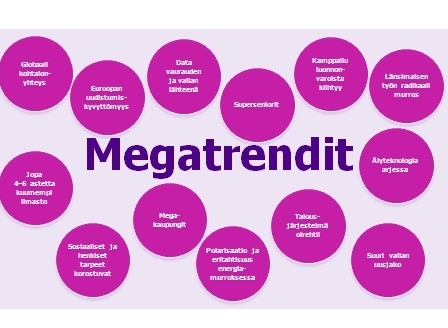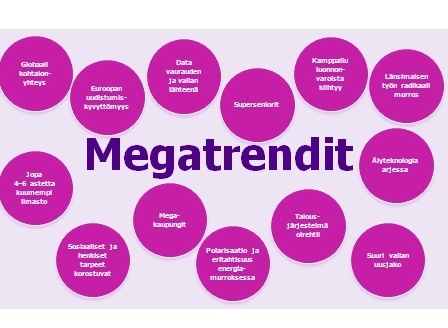This series of articles reviews the trends identified by Sitra during autumn 2013, from a variety of perspectives. This is an updated version of the article published on 3 September 2013. Further articles from the series can be found under the Recommended section on the right of the page.
The Intergovernmental Panel on Climate Change (IPCC) published a new report at the end of September 2013. The report generated moderate media buzz. It laid out the latest verdict of the international research community on climate warming. The report further confirmed that human action is the underlying cause of climate change. The report also included the IPCC’s four updated scenarios of future climate warming. The most pessimistic scenario is based on an assumption that international agreements on reducing emissions cannot be achieved. Therefore, without significant additional emission reductions, that is, with the current “business as usual” approach, the global average temperature could rise by almost four degrees Celsius.
Drastic warming would result in serious problems worldwide. A global temperature increase of four degrees would lead to a rise in the sea level and even pose a risk to global food production and the availability of drinking water. Although at first an increased amount of carbon dioxide and a slightly warmer climate could even increase agricultural production, the situation would probably take quite a different turn if the climate were four degrees warmer. It has even been suggested that the world as such could only properly provide for only about a billion people in the long run. When this is compared to the fact that, according to the current projections of population growth, the estimated population in 2050 would be nine billion, the tension between the figures is unnerving.
Even if the future does not turn out to be quite that grim, the consequences of a four-degree rise in the global temperature are nevertheless scary. In December 2013, Sitra published a possible estimate of the effects. A minor report published in Sitra’s reports series focused especially on social effects and on what a global warming of four degrees would mean in Finland (here it would mean an increase of six degrees in the annual average temperature according to estimates from the Finnish Meteorological Institute). The publication How can Finland cope in a world that is over four degrees warmer? (in Finnish Miten Suomi selviää yli 4 astetta lämpimämmässä maailmassa?) is one of the first publications to seriously discuss the consequences if we are not able to reduce greenhouse gas emission or at least slow down their growth rate significantly.
A fairly common perception among climate scientists is that we have probably already failed to keep the future global warming at less than two degrees. Warming at such a level could be a reality even in a couple of decades, and the effects dangerous. That said, the current high levels of emissions do not mean that this would definitely be the case in the future. It is still possible to more or less control warming with a stricter climate policy. However, emissions must be cut as soon as possible.
Resource efficiency
What can Finland and Finns do to improve the situation? How could our model of society be developed to radically reduce the amount of emissions?
The means vary from small everyday choices to extensive changes that affect our culture and social system as a whole. Everyday choices here refer to decisions concerning living, transportation and food. At the system level, changes are required at least to economic policy, the structure of taxation, our industrial methods and legislation as well as our cultural set of values. One set of means is presented in the report entitled Towards a sustainable well-being society published by Sitra in April 2013. The report includes an analysis of the prerequisites of a sustainable economy and society.
One important action highlighted in the report is the development of low carbon dioxide living environments, as living and commuting produce the majority of carbon dioxide emissions in industrial countries. The planning of a built environment is an important factor that shapes living and transportation. Therefore, if we wish to reduce the carbon footprint of living and transportation, we have to develop our living environment with the help of zoning, for example, so that it is easy to reduce emissions. In addition, energy savings should be the key objective when designing new houses.
Another necessary action that is even more extensive is increasing resource efficiency. The development of the living environment is also a part of this, but increasing resource efficiency is necessary in all economic operations and production.
Since economic growth has up until now also increased the amount of emissions, many social debaters and some decision-makers have started to discuss the option of decoupling economic growth from the increase of emissions. Here, it is not enough to reduce domestic emissions by transferring operations that increase emissions to, for example, China from where we will then buy our consumer products. Emissions are hazardous to our climate regardless of where they occur in the world. Instead of outsourcing emissions, they must be reduced globally. In this effort, the key and generally accepted method has turned out to be increasing resource efficiency. In practice, the goal is to produce more while reducing the consumption of natural resources.
The following issues are related to resource efficiency:
• reduced raw material and energy intensity of products and services;
• transition from using non-renewable resources to using renewable resources;
• increased reusability of raw materials and products;
• extended useful life and improved quality of products;
• transition from manufacturing products to producing services and towards more immaterial production;
• better distribution of underused resources, i.e. better use of idling capacity, a so-called sharing economy.
Limits of resource efficiency at the current pace of growth
What if resource efficiency alone is not enough? This question comes up when we ponder what the global environmental stress of human actions, including emissions, consists of. It is thought that the impact of human activity is the product of three factors: the size of the population, its level of affluence expressed as income per person and a technology factor which measures the impact of each dollar or monetary unit we spend (the technology factor also represents resource efficiency on a large scale). This should be kept in mind when the global development of carbon dioxide emissions is considered. For an increased resource efficiency to bring about an absolute reduction in emissions, it should be greater than the combined increases of population and income within the same period of time.
Even if resource efficiency has improved globally, total emissions have unfortunately increased. For example, according to professor Tim Jackson’s Prosperity Without Growth (2009), carbon intensity – the amount of emissions per production unit – has decreased globally at an annual rate of approximately 0.7 per cent since 1990. In other words, a relative decoupling per production unit has already been successful. Naturally, this improvement in resource efficiency is a good achievement, but it is not enough, as the global population has at the same time increased at an annual rate of approximately 1.3 per cent and the average real income per person at an annual rate of approximately 1.4 per cent. The growth in efficiency has not been enough to compensate for economic growth, let alone the effects of population growth. In fact, carbon dioxide emissions have increased by two per cent on average annually. An absolute decoupling that prevents the global total growth of production (economic growth) from increasing the amount of emissions has therefore not succeeded.
The IPCC has already previously emphasised that the carbon dioxide content of the atmosphere should not exceed 450 ppm. This would require decreasing global emissions at an annual rate of 4.9 per cent until 2050. However, if the population in the world increases at the rate estimated by the United Nations (0.7 per cent annually) and so does the average real income (annual rate of 1.4 per cent), the amount of emissions per production unit should decrease – in other words, global resource efficiency should improve by 7 per cent annually. That is ten times the current rate! There is a lot of catching up to do. Catching up is also complicated by the fact that part of the emission reductions achieved by resource efficiency is lost because of a so-called rebound phenomenon, where a part of the reduction achieved by efficiency is used for new consumption or additional production.
Unless such huge improvements in resource efficiency and reductions of carbon intensity can be achieved and the population growth does not come to an unexpected halt, we are left with difficult questions about the possibility of global economic growth and its desired pace. In the end, are the current growth objectives reasonable? How does this affect the national objectives of various countries? In practice, almost all countries, Finland included, try to achieve such growth – even at a maximum level.
Conflicts of interest causing a standstill
Even though compromised growth targets may seem a strange direction in light of the current economic crisis, the limits set by climate change force us to face the difficult questions mentioned above. The matter is further complicated by the fact that economic growth can also have positive effects on the local environment within a limited geographical area such as Finland. As an example, the state of our lakes is on average better than a couple of decades ago partly because we are a wealthier nation. However, the situation is not the same for climate change, which crosses national borders: as our country has become wealthier, our emissions have increased, at least if emissions caused by our improved standard of living and increased consumption outside of our national borders are included.
Even though we are already aware of the fact that increasing climate change will cause enormous and even irreversible damage that no one would want to leave for future generations, the growth of carbon dioxide emissions has been out of control. The ties to old structures have been too strong, and there has not been enough co-ordination between political sectors (such as environmental and economic policy) in order to prevent climate change systematically.
Conflicts of interest have also caused a standstill, because if a new kind of policy preventing climate change (such as an ecological taxation reform and efficient international climate agreements) succeeds, some parties currently in a position of power would have to give up their position. For example, the oil industry or other particularly energy-intensive industries, as well as various related interest groups, would be on the losing end of this necessary change. Although the change would also create new winners, any future losers who are currently still in a position of power would be able to delay the required shift towards new politics with the help of their position.
This kind of delaying tactic has been less evident in Finland – where passive avoiding of taking action rather than active delaying is the order of the day – than in the US where actions would be more significant globally. According to one analysis, almost a third of the current Members of Congress and senators in the US deny climate change to a lesser or greater extent, and this same group of people has received enormous amounts of monetary support from energy industries based on fossil fuels.
Structures and culture
Even though the development of living environments and resource efficiency are important partial solutions, more extensive structural reforms that affect our model of society as a whole are required to fight climate change. Current structures are being undone by climate change. Regardless of conflicts of interest, our complete socio-economic model must be changed so that it encourages selecting greener options. Also, it must be possible to discuss the final profitability of continued economic growth. It is also important to become aware of the fact that controlling climate change would now stress the economy less than attempting it when the situation is even worse.
In some countries, the first signs of green structural changes have begun to appear. For example, a national “energy transition” policy (Energiewende) is being used in Germany in an effort to achieve an ecologically sustainable economy. The objective of the policy is to reduce the country’s reliance on fossil fuels and nuclear power. The methods used in the German energy transition have been, for example, feed-in tariffs for renewable energy and improving the energy transmission network.
Profound changes are also required in our lifestyles and consumption culture. The current consumption culture and its strong marketing forces encourage hedonistic consumption. People work long days to achieve their materialistic objectives that should make them happy. However, studies show that materialism is not the key to happiness. New purchases often bring only momentary joy, and the extra time spent at work does not increase well-being. Also, large quantities of possessions increase disorganisation rather than happiness at home. The culture of mass consumption is also a central reason for the problem of climate change. In order to change the situation, we should focus more on increasing mental rather than material welfare. Instead of economic growth, the objective of politics should be more clearly the sustainable well-being of people.
The change towards a sustainable model of society depends mainly on the adaptation of a cultural framework, values and norms. Otherwise, a shift towards more sustainable behaviour and lifestyle cannot be achieved. New policies and methods are not developed if the culture does not support them. Neither do individuals adopt sustainable behavioural models. Cultural change and the actions of individuals form a circle: the actions of individuals change our culture slowly, and cultural changes enable behavioural changes among more and more individuals as well as the reform of politics. It is impossible to determine the starting point of the circle, but keeping it moving and speeding it up are already more important in the current climate crisis than the starting point.
Vesa-Matti Lahti
Related material:
Bill McKibben: Global Warming´s Terrifying New Math, The Rolling Stone, 2012
Intergovernmental Panel For Climate Change
Mark Lynas: Six Degrees: Our Future on a Hotter Planet
World Bank: Turn Down The Heat
Nicholas Stern in The Guardian: I got it wrong on climate change – it’s far, far worse





Recommended